Scientists have created artificial skin in the lab that could pave the way towards a more reliable cure for baldness.
The experiments involved taking tissue from mice gums and transforming it into skin that developed hair follicles.
“Our study contributes to the development of bioengineering technologies that will enable future regenerative therapies for patients with burns, scars, and alopecia (hair loss),” said Takashi Tsuji who led the study at one of Japan's largest research institutions, RIKEN.

While scientists have grown in skin before, the real breakthrough this time lies with how close the artificial skin is to the real thing.
Scientists observed how the lab-grown organ not only had the outer layer but also the dermis, which contains hair follicles and sweat glands.
In the first stages, the scientists took cells from mouse gums and turned them into generic, undifferentiated cells similar to stem cells.
These cells were then differentiated in a similar process to what happens during the development of an embryo.
Scientists then grafted these cells onto the skin of mice where it was able to, not only develop like normal skin but also connect to the nerves and muscles surrounding the tissue.
Tsuji said: "Up until now, artificial skin development has been hampered by the fact that the skin lacked the important organs, such as hair follicles and exocrine glands, which allow the skin to play its important role in regulation.
"With this new technique, we have successfully grown skin that replicates the function of normal tissue.
"We are coming ever closer to the dream of being able to recreate actual organs in the lab for transplantation, and also believe that tissue grown through this method could be used as an alternative to animal testing of chemicals."
Their study was published in the journal of Sciences Advances.
